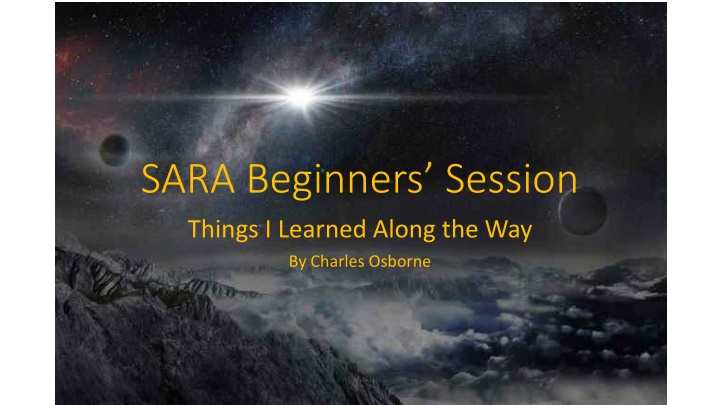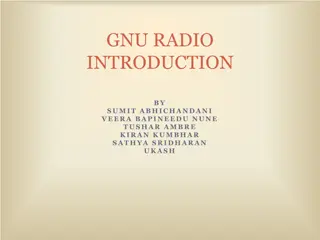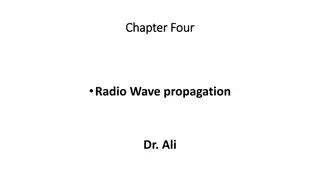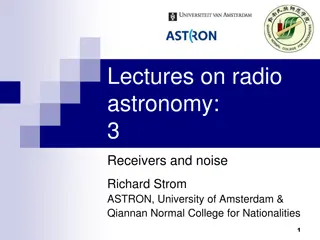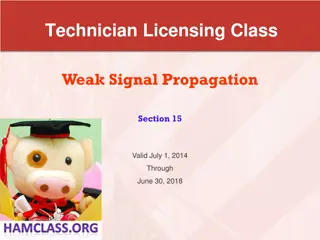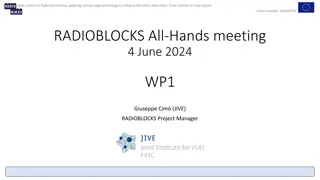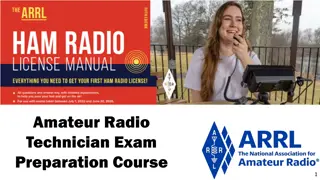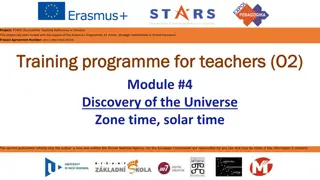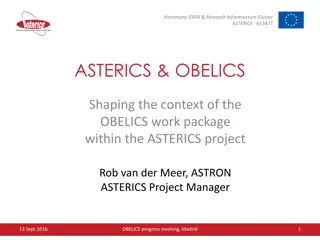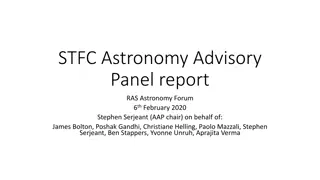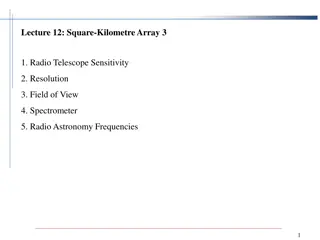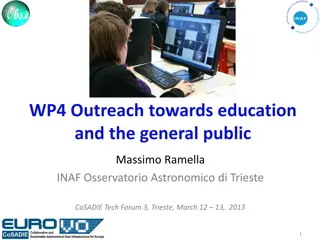Crucial Lessons in Radio Astronomy for Beginners
Developing realistic expectations for weak radio astronomy signals, managing gain drift in electronics, combating interference from modern technology, emphasizing precision in data collection, and focusing on methodical calibration are key takeaways from Charles Osborne's insights on embarking on a journey in radio astronomy.
Download Presentation

Please find below an Image/Link to download the presentation.
The content on the website is provided AS IS for your information and personal use only. It may not be sold, licensed, or shared on other websites without obtaining consent from the author.If you encounter any issues during the download, it is possible that the publisher has removed the file from their server.
You are allowed to download the files provided on this website for personal or commercial use, subject to the condition that they are used lawfully. All files are the property of their respective owners.
The content on the website is provided AS IS for your information and personal use only. It may not be sold, licensed, or shared on other websites without obtaining consent from the author.
E N D
Presentation Transcript
SARA Beginners Session Things I Learned Along the Way By Charles Osborne
Key Points Radio Astronomy signals are much weaker than anticipated. Gain drift in the electronics looks just like the signals we are trying to receive. Modern Technology (laptops, WiFi, smartphones, satellites, GPS) adds spurious and noise. Learn basic astronomy so you know where you are pointing at all times. Precision time is vital to making sense of the data and sharing results. Start out simple. Set realistic goals. Then refine and improve. Build on others work. Don t try to be a master of all things.
Radio Astronomy signals are much weaker than anticipated Begin by developing realistic expectations of what you will see.. At 1420 MHz the signals are weak even on large antennas. On a 10ft dish only the Sun is a few dB. Most other signals like CasA, the Moon, Cygnus will be fractions of a dB. It s all about Temperature. You will get tired of hearing Kelvin used in so many different ways in radio astronomy. But basically we are measuring energy changes and relating them to the RF energy created by a resistor heated to x Kelvin. At room temperature 290 Kelvin this is -174 dBm/Hz, a good number to memorize. Noise Figure or the noise added by the receiver s electronics noise is also measured in equivalent Kelvin [pass out spiral noise calculators].
Gain drift in the electronics looks just like the signals we are looking for. Most people jump into observing with great anticipation and label every peak as astronomical in origin. In fact the best place to start is by placing a 50-ohm termination on the LNA input. If you still see fluctuations, you have work to do in stabilizing the system. Put everything you can away from the Sun s heat and inside thermally controlled boxes. Shield the receive electronics from home heating vents. Calibration noise sources are universally used to gauge the sensitivity of the system. Use them frequently. Otherwise the data is meaningless if not referenced to repeatable calibrations. It is too easy to accidentally change something and proclaim an improvement in system performance when there was none. Scale is critical. Without it you won t even know if something has died in the chain. Dead parts thermal noise looks disturbingly like working system noise. Going back to a known source to compare past measurements will show the difference. People who skip this step usually end up taking meticulous data of wasp nests in their feed or water filled coax. Take good notes. Make it a habit. Years later it can be the difference between realizing you witnessed something you can add your data to, or just gibberish that gets ignored.
Modern Technology (laptops, WiFi, smartphones, satellites, GPS) adds spurious and noise. Don t claim you found a pulsar or Jupiter S-Bursts, only to discover it s your neighbor s lawn mower ignition noise. Our world is full of sources of RF. It is ubiquitous. It is funny to watch folks chase transient interference only to find out they are wearing it (cellphones). Strong intermittent signals even if nowhere near the frequency of interest can overwhelm sensitive front ends and cause gain compression which mimics noise coming and going. Airplane traffic often generates radar reflections and other signals near the Hydrogen line. GPS, Iridium, and XM/Sirius satellites put more watts per square foot onto the Earth than almost any other satellites. That s why their hand held receivers work well with antennas the size of a silver dollar. Filter out those frequencies if possible. Or just learn to recognize the periodicity of the interference and comment out the data it corrupts. Most large observatories have automated software routines to do the same thing today.
Learn basic astronomy so you know where you are pointing at all times. Right Ascension, Declination, Azimuth, Elevation, Local Sidereal Time conversions are crucial. Double check your understanding using simple astronomy programs and the Moon, Sun, and a few key constellations. Verify using shadows of the Sun at precise time of day to prove you are not off by an hour due to Daylight Savings Time. Point a small dish at where you think due South is. Record the peak power and when it occurred. Compare with the astronomy program. Refine your understanding by pointing southeast or southwest at lower angles intersecting the Sun s arc. In the most basic case, just do this with a stick and shadows. Make sure your watch is set within a minute of correct. Find the North Star to double check your compass assumptions. Due South is key. That gives the ability to see the lowest in declination. Galactic center is a bright radio source. But at high latitudes you may see tree thermal noise or ground noise first making it more difficult.
Precision time is vital to making sense of the data and sharing results. GPS Time provides a way of precisely setting system clocks if you do not have Internet access. Otherwise use Internet time servers to keep your logging computer within a second of correct. This will add validity to your data. If everyone did it religiously we would have a much better record of solar flares, meteor bursts, gamma ray burst transients, or interference to compare with each other. Take good notes. What antenna, LNA, frequency, receiver, bandwidth, noise temperature, system settings, station location latitude, longitude, etc. Think of it as if you were going to put the data in a time capsule and look at it in ten years. What would you want to have written down rather than trusting to memory. What was the intended target. Was the antenna fixed or tracking? Local conditions even of weather may prove useful if it was raining, temperature, sunny, how much wind was there? Make all these things a header in your data file if possible.
Start out simple. Set realistic goals. Then refine and improve. Build on others work. Generally those who have the most success start with RadioJOVE or SuperSID to learn the basics with a great chance of accomplishing the goal. Those who buy a 16ft dish, electronics, tracking motors, FFT processors, LNAs, and computer equipment only to get a small bump on a graph after much effort.. Well.. they sell it all or just switch hobbies. It s almost exactly the analogy of the beginning optical astronomer buying a 16 Meade telescope and observatory dome as their first telescope. A good success oriented path to bigger and better things for most people seems to be: Acquire Basic Astronomy knowledge RadioJOVE or SuperSID Solar and Jupiter observing Drift scan Hydrogen line with 8ft dish Larger tracking dish for weaker sources or different bands. Some delve in the SETI hunt at this juncture. Molecular line receiver : OH, methanol, Formaldehyde Or a second dish for interferometry
Dont try to be a master of all things. We are not all mathmeticians, programmers, astrophysicists, or microwave electrical engineers. Don t be discouraged if you run into stumbling points. Get help so you can keep going in continuing to learn about the areas you are curious about. Or skip some that you will not likely enjoy learning and just buy that part. Or trade your expertise with someone who needs a complementary skill. Some of our most advanced members have teamed with others to do more than either could have alone. Continuous improvement is the ideal path to enlightenment.
If you are looking for fame and fortune, keep looking. Most of us started out in optical astronomy wowed by Hubble pictures or Astronomy magazine colorful awe inspiring photoshop masterpieces. Radio astronomy is none of that. It is a lot like watching a chart recorder or seismometer. You are unlikely to get an Ohh! Or Ahh! Out of your coworkers for showing them a bump on a graph. But if you explain that the bump comes from 26,000 light years away, and you built all the electronics to receive it yourself, you might get a Wow! But from a spouse generally you best consider it a success if you get a That s nice dear. To the non-scientific majority what we do is pretty close to stamp collecting in excitement. But you can always look to other SARA members for a pat on the back. Like John F. Kennedy said we don t do this because it is easy, we do it because it is hard.
